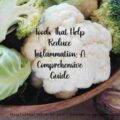We may earn money or products from the companies mentioned in this post.
Is it possible to reduce inflammation with yog? Yoga has become an increasingly popular form of exercise in recent years, and for good reason. It offers a variety of benefits for both the mind and body. This includes reducing inflammation with yoga and yoga poses.
Inflammation is the body’s natural response to injury or infection, but when it becomes chronic, it can lead to a host of health problems such as heart disease, diabetes, and arthritis.
Yoga has been shown to be an effective way to reduce inflammation in the body. It does this by reducing stress, which is a major contributor to chronic inflammation. When the body is under stress, it produces cortisol, a hormone that can cause inflammation.
Yoga helps to reduce stress by calming the mind and body, which in turn reduces the production of cortisol. Additionally, certain yoga poses can help to stimulate the lymphatic system, which plays a key role in the body’s immune response and can help to reduce inflammation.
In this article, we will explore how yoga can help to reduce inflammation in the body. We will examine the science behind this claim and provide examples of specific yoga poses that can be used to reduce inflammation. Whether you are new to yoga or a seasoned practitioner, this article will provide you with valuable information on how to use yoga to improve your overall health and well-being.
Understanding Inflammation
What is Inflammation?
Inflammation is a natural response of the body’s immune system to injury, infection, or irritation. It is a complex process that involves the release of various chemicals and cells that work together to protect the body from harmful invaders.
Inflammation can be acute or chronic. Acute inflammation is a short-term response that occurs when the body is injured or infected. Chronic inflammation, on the other hand, is a long-term response that can occur when the body is exposed to harmful substances over a prolonged period.
Causes of Inflammation
Inflammation can be caused by various factors, including infections, injuries, exposure to toxins, stress, and unhealthy lifestyle habits such as poor diet and lack of exercise. Certain medical conditions such as autoimmune disorders and allergies can also cause inflammation.
Symptoms of Inflammation
The symptoms of inflammation can vary depending on the cause and severity of the inflammation. Common symptoms of acute inflammation include redness, swelling, pain, and warmth in the affected area. Fever, fatigue, and loss of appetite may also occur.
Chronic inflammation, on the other hand, may not cause any noticeable symptoms at first but can lead to serious health problems over time, such as heart disease, diabetes, and cancer.
In conclusion, understanding inflammation is essential for managing and preventing various health problems. By making healthy lifestyle choices such as eating a balanced diet, getting regular exercise, and reducing stress, individuals can help reduce their risk of inflammation and its associated health problems.
Yoga and Inflammation
Inflammation is a natural response of the body to injury or infection. However, chronic inflammation can lead to various health problems, such as heart disease, diabetes, and arthritis. Yoga is a mind-body practice that has been found to be effective in reducing inflammation and promoting overall health and well-being.
How Yoga Helps Reduce Inflammation
Yoga helps reduce inflammation by reducing stress and promoting relaxation. Chronic stress can cause inflammation in the body, and yoga can help reduce stress levels. Yoga also improves circulation and lymphatic drainage, which helps remove toxins from the body and reduce inflammation.
In addition, yoga helps regulate the immune system, which plays a key role in inflammation. Research has shown that yoga can decrease the production of pro-inflammatory cytokines, which are proteins that contribute to inflammation.
Types of Yoga for Inflammation
There are many types of yoga, but some are particularly effective in reducing inflammation. Restorative yoga, for example, is a gentle form of yoga that uses props to support the body in relaxing poses. This type of yoga is particularly effective in reducing stress and promoting relaxation.
Yin yoga is another type of yoga that is effective in reducing inflammation. This practice involves holding poses for several minutes, which helps improve circulation and lymphatic drainage.
Best Yoga Poses for Inflammation
There are several yoga poses that are particularly effective in reducing inflammation. Some of the best yoga poses for inflammation include:
- Child’s Pose: This pose helps promote relaxation, reduce stress, and stretch the hips and thighs.
- Downward-Facing Dog: This pose helps improve circulation and lymphatic drainage, and stretches the hamstrings and calves.
- Cat-Cow Pose: This pose helps improve spinal flexibility and reduce stress.
- Warrior II Pose: This pose helps improve circulation and lymphatic drainage, and strengthens the legs and core.
- Bridge Pose: This pose helps improve circulation and lymphatic drainage, and stretches the chest, neck, and spine.
In conclusion, practicing yoga can be a powerful tool in reducing inflammation and promoting overall health and well-being. By reducing stress, improving circulation and lymphatic drainage, and regulating the immune system, yoga can help reduce chronic inflammation and improve overall health.
Other Natural Remedies for Inflammation
In addition to yoga, there are several other natural remedies that can help reduce inflammation. These remedies include dietary changes, herbal supplements, and lifestyle changes.
Dietary Changes
Certain foods can exacerbate inflammation, while others can help reduce it. For example, foods high in sugar, refined carbohydrates, and saturated fats can increase inflammation, while foods high in fiber, omega-3 fatty acids, and antioxidants can help reduce it. Some foods that can help reduce inflammation include:
- Fatty fish like salmon, tuna, and sardines
- Leafy greens like spinach, kale, and collard greens
- Berries like blueberries, strawberries, and raspberries
- Nuts and seeds like almonds, walnuts, and chia seeds
- Turmeric, ginger, and other anti-inflammatory spices
Herbal Supplements
Several herbal supplements have anti-inflammatory properties and can help reduce inflammation. Some of the most popular supplements include:
- Curcumin, the active ingredient in turmeric
- Ginger extract
- Boswellia extract
- Green tea extract
- Resveratrol, found in red wine and grapes
It’s important to note that while these supplements may be helpful, they should not be used as a substitute for medical treatment.
Lifestyle Changes
In addition to dietary changes and supplements, certain lifestyle changes can also help reduce inflammation. These changes include:
- Getting regular exercise
- Getting enough sleep
- Reducing stress
- Quitting smoking
- Limiting alcohol consumption
By incorporating these natural remedies into their daily routine, individuals can help reduce inflammation and improve their overall health.
When to Seek Medical Help
While yoga can be a helpful tool in managing inflammation, there are some cases where seeking medical help is necessary. Here are a few situations where it is important to seek medical attention:
- Severe Pain: If you experience severe pain while practicing yoga, it is important to stop immediately and seek medical attention. This could be a sign of a more serious injury or condition.
- Difficulty Breathing: If you experience difficulty breathing during yoga practice, stop immediately and seek medical attention. This could be a sign of a respiratory issue or other underlying condition.
- Worsening Inflammation: If you notice that your inflammation is getting worse despite practicing yoga and other lifestyle changes, it is important to speak with a medical professional. They can help determine if there is an underlying condition that needs to be addressed.
- New Symptoms: If you experience new symptoms that are not related to your inflammation, it is important to seek medical attention. This could be a sign of a new condition or illness that needs to be addressed.
It is important to remember that yoga is not a substitute for medical treatment. While it can be a helpful tool in managing inflammation, it is important to seek medical attention when necessary.
Read these next:















